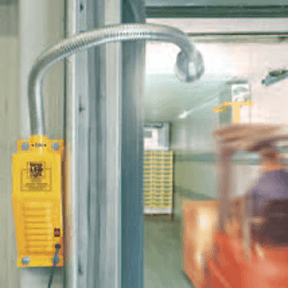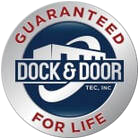|
No matter if you want to do it for the environment or to save money — reducing energy use is a smart idea. When you’re considering ways to cut energy consumption at your facility, don’t overlook one of the biggest sources of energy loss, the loading dock. Essentially, a loading dock creates a giant hole in the side of your warehouse, and without the right equipment (properly maintained), it can cause major heating/cooling escape. Here are five ways you can save energy and make your dock impermeable to outside weather.
1. Repair or Replace Damaged Dock Doors Dock doors and levelers damaged by forklifts, other vehicles, or from general wear and tear often have gaps along the door frame or compromised seals. These openings allow hot or cold air to come into your warehouse and cause your air conditioners to work overtime. Not to mention, dinged doors often become misaligned on their tracks and are difficult to open and close. This discourages loading dock workers from ever closing the door and produces even more wasted energy. If you only have minor dents and dings on your overhead door you may be able to fix the problem by just replacing the bottom panel. But, if you have considerable damage, you’ll have better results by upgrading to a fully impactable door, which eliminates air escape and is capable of taking a hit without being damaged. Similarly, levelers can be repaired to ensure they’re sealed correctly, but you may also want to consider installing a new product, such as a vertical storing leveler that has state of the art energy efficiency features. 2. Use Seals & Shelters Having a well-fitted dock door is your first step in eliminating drafts, but for an even better outcome, you should include seals and shelters throughout your dock area. For example, compression seals attach to the perimeter of the dock door and are made of rugged fabric and foam, so when a trailer backs into the loading bay they compress and effectively seal any openings. Also, if you have a pit-style leveler, air may be escaping from the spaces around the equipment. However, you can outfit your leveler with a weather seal system, such as the Leveler Koozi, which is made of heavy-duty foam and acts as an insulator for warm or cold climate control. Another option, is to use a leveler blanket. These blankets lay on top of your leveler when it’s not in use, and although simple, they are effective at blocking drafts. Shelters provide another layer of protection against the outside elements and are generally used in conjunction with seals. They are typically made of durable fabric or foam that attaches around the tops and sides of the trailer and dock door to create a weatherproof enclosure between the two areas. Since both seals and shelters are positioned on the border of door and trailer, unloading and loading is not impeded, and with the availability of options like foam, inflatable systems, curtains, pads, and an assortment of shelters, there’s virtually no loading dock that can’t be weatherproofed. 3. Rely on a Dock Management System When you combine your yard, loading dock, and warehouse logistics into one, software powered dock management system, you can create a much more streamlined operation. This means less opening and closing of doors, faster loading and unloading, and fewer trucks idling in wait (wasted fuel) — all of which means saved money. 4. Install Truck Restraints In addition to having huge safety benefits, truck restraints also are great at controlling energy use by keeping trailers securely in place. With the truck in a constant position, the seals and shelters are better able to do their jobs, and no air will escape because of the trailer shift. 5. Install LED Light Fixtures Incandescent bulbs are energy hogs and typically have a shorter product life than LED lights. Replacing your old bulbs with LED lights can make a big difference in your energy savings while still providing the high-quality light you need to illuminate your loading area. Modern lights, such as the LED Versa Light, not only reduce energy costs, but are capable of illuminating whole trailers, can resist impacts, and provide a safer and more productive work environment. If these benefits aren’t motivation enough to upgrade bulbs, the Federal Government, as part of its Energy Independence and Security Act, is planning to phase out traditional incandescent light bulbs (the 100-watt bulb is expected to be gone this year), so planning to make the switch now may make the transition easier. There are many more ways to reduce your loading dock’s carbon footprint and increase savings, but you can see significant and immediate changes just by implementing the strategies above. And with rising utility costs and outside pressure from the government and society to be “green,” these are modifications you can’t afford not to make. |
AuthorVarious. Categories
All
Archives
August 2023
|
- Home
- About
- Career Opportunities
- Services
-
Equipment
- Dock Locks (Truck Restraints) >
- Fans & In-Plant Equipment >
-
Industrial / Commercial Doors
>
- High Speed Fabric Doors
- Security High Speed
- Rubber Doors
- Fire Door
- Rolling Steel
- Impactable Dock Doors
- Cooler / Freezer
- Fabric Roll-Up
- Impact / Traffic / Bump
- Overhead / Sectional Doors
- Operators / Activation
- Air Curtains / Screen & Bug Doors
- Strip Doors
- Door Entrapment Protection
- Door Protection
- Overhead Door Upgrades
- Loading Dock Levelers & Lifts >
- Loading Dock Seals & Shelters >
- OEM & Aftermarket Parts
- Safety / Energy / Security / Employee Comfort >
- Yeti Snow Removal
- Markets
- Blog
- Contact
Dock & Door Tec
Serving Minnesota, Wisconsin, Iowa, North Dakota & South Dakota
Serving Minnesota, Wisconsin, Iowa, North Dakota & South Dakota


 RSS Feed
RSS Feed
